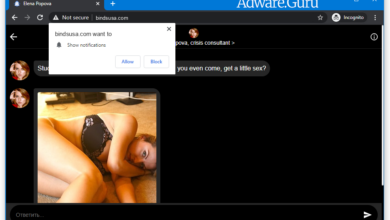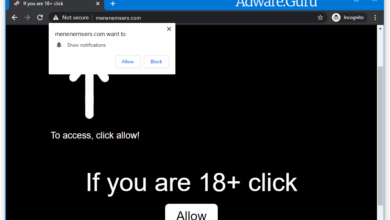Ahui Virus Removal Guide (+Decrypt .ahui files)
Ahui – General Information
Ahui is a destructive software application that operates as common ransomware. The renowned malware researcher, Michael Gillespie, first discovered this new variant in the DJVU ransomware family.
The primary purpose of Ahui is to encrypt various types of files, rendering them inaccessible to users. Once the encryption process is completed, Ahui adds its own “.ahui” extension to the encrypted files. For example, a file named “price_list.xls,” when encrypted by Ahui, will be renamed as “price_list.xls.ahui.” Additionally, Ahui places a distinctive text file (_readme.txt) in every folder containing the encrypted files.
The content of the text file resembles the ransom notes seen in other DJVU ransomware variants. It informs the user that their files have been locked and that the only way to regain access is by using a unique decryption key. Unfortunately, this statement is indeed true.
The specific technique used by Ahui to encrypt files has not been fully researched. However, each computer owner is issued a unique decryption key that is extremely difficult to recover the data without it.
“Don’t worry, you can return all your files!” – Message from _readme.txt:
Another notable characteristic of the Ahui infection is that users cannot access the decryption key themselves. The key is stored on a special server under the complete control of the criminals behind the Ahui virus. To obtain the key and restore the critical data, users are instructed to contact the perpetrators via email or Telegram and pay a ransom amount of $980.
The message also states that individuals must contact the Ahui authors within 72 hours of the data encryption. By doing so, they will receive a 50% discount, reducing the ransom amount to $490.
Ahui encrypted your data, however, it may not be the only risk on your PC. Plus, the ransomware might be hidden deep in the system. To find and erase the danger totally, we advise you to refer to the help of GridinSoft Anti-Malware tool.
Download GridinSoft Anti-Malware
GridinSoft Anti-Malware Review, How to get free trial?, EULA, and Privacy Policy.
No matter what the quantity of the ransom is, we strongly encourage that you do not pay the ransom. There is no guarantee that these online scoundrels will keep their pledges, so they might not care at all what the victims feel about the encryption, even when the amount of the ransom is received into their accounts. Hence, paying ransom frequently does not lead to an effective healing. So, the users might merely lose their money for nothing.
Likewise, we urge you not to get in touch with the scams as they instruct. Do not transfer cash into their wallets. There are no applications that might break the Ahui ransomware or bring back the information at no charge. Therefore, the only right choice is to restore the information from possible backups (if offered).
Virus Summary
| Name | Ahui Ransomware |
| File Extension | ahui |
| Type | Ransomware |
| Family | DJVU |
| Short Description | The ransomware encrypts all the data stored on your system and requires a ransom to be paid on your part supposedly to recover your important files. |
| Symptoms | File encryption by the ransomware is performed by means of the AES-256 algorithm (CFB mode) encryption algorithm. Once the encryption is completed, the ransomware adds its special .ahui extension to all the files modified by it. |
| Distribution Method | Adware bundles and software cracks |
| Similar Infections | Lokas, Besub, Nusar |
| Ahui Removal Tool | GridinSoft Anti-Malware |
| Ahui Decryption Tool | Emsisoft Djvu Decryptor |
Do not forget that the Web is now filled with infections similar to the Ahui ransomware. For example, this specific risk is essentially similar to Brusaf and other ransomware-type infections. These harmful utilities have actually been established in order to encrypt the important data and reveal the need for the users to pay the ransom. All these infections use the identical algorithm to produce the particular key for successful files decryption.
Unless the Ahui ransomware is still under the advancement process or has actually got some concealed bugs, it is not possible to bring back the data by hand. Therefore, the only working solution to avoid the loss of your essential data is to regularly maintain current backups of all your important files.
Another important piece of advice is to save the backups on special storage not linked to your main device. For example, you might store it on the USB Flash Drive, or some external hard disk, or by using the cloud data storage services. Keeping the backups on your regular drive is extremely dangerous, because the backup may also be encrypted by the Ahui .
Leakages for the Ahui ransomware attack.
Ahui uses numerous paths to penetrate the vulnerable computers. It is not certain what specific approach was utilized in your case, however, the intrusion might happen via the following channels:
- bundling with third-party programs, mainly freeware;
- spam emails from the unknown senders;
- websites supplying free hosting;
- P2P (peer-to-peer) torrent downloads.
There are times when the Ahui ransomware may camouflage itself as some real application, for example, through the misleading informs requiring setup of some software upgrade. This is the most common trick utilized by the frauds to inject the Ahui virus files into the system. In this manner users partly participate in its setup, without plainly understanding the danger.
In addition, the scams may send unsolicited spam email with difficult signals encouraging the people to open dubious attachments or click some download links, for example, those encouraging the people to open particular photos, text files, tax documents and other info.
No doubt, opening these files or clicking on the harmful links might basically harm the system. Fake Adobe Flash Player update alerts may lead to the Ahui ransomware seepage. Likewise, downloading the broken software application might in addition include the ransomware installer. The last but not the least, setup of Ahui may happen through some Trojan horses that may be set up stealthily into the system and without the user’s direct consent and even consent.
Preventing the Ahui virus injection.
Obviously, there is no absolute assurance that your computer will be constantly free of any malware attacks, however, we would like to share some beneficial tips with you to make it much safer. Ensure to pay extremely close attention while searching the web and specifically while downloading cost-free programs. Do not open any dubious email attachments, particularly if the sender is not known to you.
Do not forget that specific freeware installer might also include some other additional apps in the package. These extra applications may be really destructive. It is of utmost significance to keep your anti-virus software application and your operating system in basic to be always appropriately updated.
It is quite sensible that downloading pirated apps is unlawful, nevertheless, in addition, such unapproved software application usage may likewise bring serious damage to your PC. Hence, do not download any broken programs. Plus, the fact that your present anti-virus did not protect the system from the Ahui ransomware is a good factor for you to reconsider your choices and change to another program that can render the safeguarding functions on a far better level.
Below please find the quotation from the Ahui text file:
ATTENTION! Don't worry, you can return all your files! All your files like photos, databases, documents and other important are encrypted with strongest encryption and unique key. The only method of recovering files is to purchase decrypt tool and unique key for you. This software will decrypt all your encrypted files. What guarantees you have? You can send one of your encrypted file from your PC and we decrypt it for free. But we can decrypt only 1 file for free. File must not contain valuable information. You can get and look video overview decrypt tool: https://we.tl/t-2P5WrE5b9f Price of private key and decrypt software is $980. Discount 50% available if you contact us first 72 hours, that's price for you is $490. Please note that you'll never restore your data without payment. Check your e-mail "Spam" or "Junk" folder if you don't get answer more than 6 hours. To get this software you need write on our e-mail: [email protected] Reserve e-mail address to contact us: [email protected] Our Telegram account: @datarestore
Screenshot of files with “.ahui” extension added by the virus:”

Use GridinSoft Anti-Malware to remove Ahui ransomware from your computer
1.Download GridinSoft Anti-Malware.
You can get GridinSoft Anti-Malware by clicking the button below:
2. Double-click on the setup file.
When setup file has finished downloading, double-click on the setup-antimalware-ag.exe file to install GridinSoft Anti-Malware on your computer.

An User Account Control asking you about to allow GridinSoft Anti-Malware to make changes to your device. So, you should click “Yes” to continue with the installation.

3. Press Install button for run GridinSoft Anti-Malware.
3.Once installed, GridinSoft Anti-Malware will automatically run.
4. Wait for the GridinSoft Anti-Malware scan to complete.
GridinSoft Anti-Malware will automatically start scanning your computer for Win Speedup 2018 and other malicious programs. This process can take a 20-30 minutes, so we suggest you periodically check on the status of the scan process.

5. Click on “Clean Now”.
When the scan has completed, you will see the list of infections that GridinSoft Anti-Malware has detected. To remove them click on the “Clean Now” button in right corner.

Use Emsisoft Decryptor for restore ahui files
You can download Emsisoft Decryptor by clicking the button below:
- Run the decryptor as an administrator. The license terms will show up, which you have to agree to by clicking the “Yes” button.
- Once the license terms are accepted, the primary decryptor user interface opens.
- By default, the decryptor will pre-populate the locations to decrypt with the currently connected drives and network drives. Additional locations can be added using the Add” button.
- Decryptors typically offer various options depending on the particular malware family. The available options are located in the Options tab and can be enabled or disabled there. You can find a detailed list of the available Options below.
- After you have added all the locations you want to decrypt to the list, click the “Decrypt” button to start the decryption process. The screen will switch to a status view, informing you about the current process and decryption status of your files
- The decryptor will inform you once the decryption process is finished. If you require the report for your personal records, you can save it by clicking the “Save log” button. You can also copy it straight to your clipboard to paste it into emails or forum posts if you are asked to.








